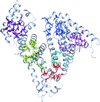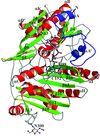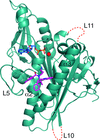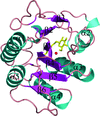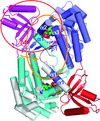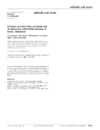issue contents
October 2012 issue

Cover illustration: CofA, a major pilin subunit of colonization factor antigen III from human enterotoxigenic Escherichia coli (p. 1418). Top view of the CofA filament model. The filament diameter is approximately 80 Å.
research papers
X-ray absorption spectroscopy (XAS) was used in combination with protein crystallography to study the zinc sites in T6, T3R3 and R6 bovine insulin. The information obtained by XAS is highly accurate and complementary to that obtained from the crystal structures.
Small crystals of contaminant protein led to the structure at 1.9 Å resolution of Strep-Tactin in complex with desthiobiotin. Trace amounts of Strep-Tactin were observed to be eluted from a Strep-Tactin column using several detergents, illustrating their possible role in the contamination when crystallizing membrane proteins.
PDB reference: streptavidin triple mutant, complex with desthiobiotin, 4dne
Four crystal structures of bovine, equine (two crystal forms) and leporine serum albumin have been determined at resolutions of 2.04–2.47 Å. The proteins were isolated from animal blood and additionally defatted and purified.
PDB references: bovine serum albumin, 4f5t; equine serum albumin, 4f5s; 4f5u; leporine serum albumin, 4f5v
The high-resolution crystal structure of TcpG identifies a short contact in the oxidized form.
PDB reference: TcpG, 4dvc
The crystal structure of the naturally isolated pollen allergen Cyn d 4 from Bermuda grass provides a structural basis for the enhancement of protein stability by the conserved N-terminal segment, the function of the protein and the various cross-allergenicities of the grass pollen group 4 allergens.
PDB reference: Cyn d 4, 4dns
Open  access
access
 access
accessThe complex between the motor protein Eg5 and the phase II clinical candidate ispinesib provides insights into the mechanism of action of this important class of inhibitors.
PDB reference: Eg5–ADP–ispinesib complex, 4ap0
In an effort to better understand the control of the formation of branched fatty acids in Micrococcus luteus, the structure of β-ketoacyl-ACP synthase III, which catalyzes the initial step of fatty-acid biosynthesis, has been determined.
PDB reference: MlFabH, 4ewp
The structure of the VibB ISC domain in complex with isochorismate was determined at atomic resolution. The positions of both of the catalytic waters are significantly affected by the mutation of Asp35 and Lys118.
Structural insights into a new class of monomeric GH39 β-xylosidases.
PDB reference: CcXynB2, 4ekj
Short-length motifs that were identified from partially conserved cadmium-binding sequences resemble the structural patterns identified from cadmium architecture and are postulated to have a higher probability of coordinating to cadmium.
Open  access
access
 access
accessThe structural characterization of acyl-carrier-protein synthase (AcpS) from three different pathogenic microorganisms is reported. One interesting finding of the present work is a crystal artifact related to the activity of the enzyme, which fortuitously represents an opportunity for a strategy to design a potential inhibitor of a pathogenic AcpS.
Open  access
access
 access
accessThe optimization of WbdD crystals using a novel dehydration protocol and experimental phasing at 3.5 Å resolution by cross-crystal averaging followed by molecular replacement of electron density into a non-isomorphous 3.0 Å resolution native data set are reported.
The crystal structures of XccFimXEAL–c-di-GMP and XccFimXEAL–c-di-GMP–XccPilZ complexes have been determined to a resolution of 2.50 and 2.70 Å, respectively. The two c-d-GMP in the two complexes are found to adopt a novel conformation.
A new crystallization support and associated method designed to fully automate the process of crystal harvesting is presented. In this system, crystals are grown on an ultrathin film that can be excised by laser photoablation and directly attached to a pin for X-ray diffraction experiments.
The crystal structure of the extrinsic soluble domain of PetC, the Rieske subunit of the cytochrome b6f complex, from the thermophilic cyanobacterium T. elongatus has been determined at 2.0 Å resolution. Its surface revealed a deep pocket possibly oriented towards the membrane surface within the full complex, with properties suggesting a binding site for a hydrophobic compound.
PDB reference: TePetC, 3azc
The structure of the autophagic E2 conjugating enzyme Atg10 has been determined at 2.7 Å resolution. Unique features of Atg10 compared with other E2 enzymes, including Atg3, another autophagic E2 enzyme, are described.
PDB reference: Atg10, 4ebr
The structure of CofA, a major pilin subunit of colonization factor antigen III, is reported.
PDB reference: CofA, 3vor
Open  access
access
 access
accessA repetitive measurement of the same diffraction image allows to judge the performance of a data collection facility.
addenda and errata
Free 

Free 



 journal menu
journal menu













